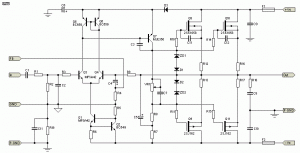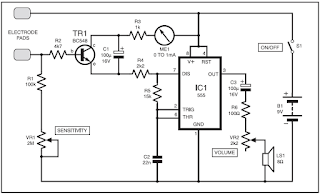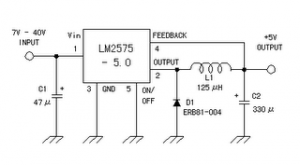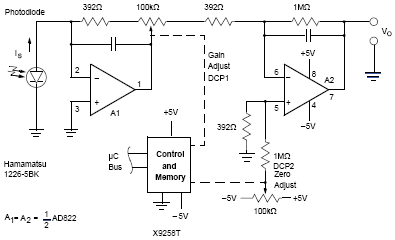Tuesday, November 11, 2014
LED flasher with Transistor circuits Diagram
These circuits only flash one or two LEDs. This is opposed to the light chaser circuits that can flash four or more. Of course, the simplest LED flasher is simply to use a flashing LED. The problem with that approach is you have no control over the flash rate, but it does have its use for eye catching displays for selling stuff. The circuits below give you that control, plus they can flash two LEDs alternately.
There are many possible applications for the circuits below, especially for kids, who love flashing lights. Heres some possible uses.
- Railroad crossing signal for model railroads.
- Safety blinkers for bicycles, etc.
- Fun stuff for Halloween, like making those plastic Jack-O-lanterns blink (try using ultraviolet LEDs here).
- Christmas decorations.
- Blinkers to locate items in the dark.
Transistor LED flasher
This circuit has a lot going for it. For one thing, it only consists of two transistors, two capacitors and four resistors. That also means it consumes very little power. You can control the flash rate by changing the size of the 100k resistors (100k makes for a pretty slow rate). You can also control the duty cycle by using resistors of different values on the two sides. The 470 ohm resistors control the current through the LEDs. Normally you want to limit this to 20mA, but to conserve battery power, you may need to limit it even further. You can also connect several LEDs in series, instead of using only one for each side. With red LEDs (1 per side) and the values shown, the circuit draws about 11mA. Heres what the actual circuit looks like:
On this circuit, the green wires connect to the LEDs, but you can mount them on the actual circuit board for some applications. The picture is about twice actual size.
Sunday, November 9, 2014
Car Reverse Horn
Most of people have there own vehicles.so I suppose this circuit will be very useful circuit for them.This circuit is a car reverse horn.If you can build your own circuit for your car I think that is great.Here I have used common Music generator IC UM 66.The out put voltage of UM66 is not enough to make a good car reverse horn so by using two transistors (BC148 and BEL187)I have increased it.

# This circuit operates with 12V power supply
# Build this circuit on a PCB to get good results
# use 8ohm speaker.
# Use only push to on switch.
Saturday, November 8, 2014
Voice Bandwidth Filter
This circuit passes frequencies in the 300Hz - 3.1kHz range, as present in human speech. The circuit consists of cascaded high-pass and low-pass filters, which together form a complete band-pass filter. One half of a TL072 dual op amp (IC1a) together with two capacitors and two resistors make up a second-order Sallen-Key high-pass filter. With the values shown, the cut-off frequency (3dB point) is around 300Hz. As the op amp is powered from a single supply rail, two 10kO resistors and a 10µF decoupling capacitor are used to bias the input (pin 5) to one-half supply rail voltage.
Circuit diagram:
The output of IC1a is fed into the second half of the op amp (IC1b), also configured as a Sallen-Key filter. However, this time a low-pass function is performed, with a cut-off frequency of about 3.1kHz. The filter component values were chosen for Butterworth response characteristics, providing maximum pass-band flatness. Overall voltage gain in the pass-band is unity (0dB), with maximum input signal level before clipping being approximately 3.5V RMS. The 560O resistor at IC1bs output provides short-circuit protection.
Going for Gold Circuit Diagram
The title refers to a popular TV game show where the contestants each have a big button. The game show host asks a question and the first contestant to press their but-ton makes an illuminated indicator light up on their desk. The other contestants’ buttons are automatically inhibited, so that everyone can see who was the first contestant to press their button, and so is allowed to answer the question. The project described here shows how to build a similar sortof refereeing device yourself, using simple resources and without needing a microcontroller, which is pretty rare these days! The basic circuit is for just two contestants, but the modular design means it can easily be expanded.
Circuit diagram :
Going for Gold Circuit Diagram
The diagram shows three buttons: S2 and S3 are the buttons for the two contestants, S1 is the button for the host, which allows them to reset the circuit before each fresh question. The ‘brains’ of the circuit is IC1, a 4013 dual D-type flip-flop, of which only the Set and Reset inputs are used here. This circuit can handle quite a wide supply voltage range, from 3 to 15 V, and so the project can easily be run off a 4.5 V battery pack (the power consumption is minimal).
IC1 is armed by pressing S1 (reset). In this state, the non-inverting outputs (pins 1 and 13) are at 0 and the inverting outputs (pins 12 and 12) are at 1. Hence line A is pulled high by R1, since diodes D2 and D4 are not biased on. If contestant 1 presses button S2, the non-inverting output of flip-flop IC1a goes to logic 1, and LED D1 lights via T1 to indicate that contestant 1 has pressed the but-ton. At the same time, the flip-flop’s invert-ing output goes to logic 0, making diode D2 conduct. Line A is now pulled down to 0, and consequently contestant 2’s button S3 can no longer trigger the second flip-flop. The reverse happens if it is contestant 2 who presses their button S3 first.
The circuit can be extended to 4 or 6 contest-ants (or even more) by adding a second or third (or more) 4013 IC. All you have to do is repeat the circuit (minus R1, R2, and S1) and connect to the A, B, Vdd, and 0 V lines on the right-hand side.
Guitar Effect Pedal Power
A small box is fitted to the rear of the amplifier providing a 9V output for the effect pedal. The amplifier section gets 9V through a pedal switch. This power output and guitar signal input lines are combined into a single unit with multi-way cable connecting points as shown in the following figure.
Guitar Effect Pedal Power diagram :
Guitar Effect Pedal Power Circuit Diagram
The circuit can be divided into two sections: power supply and signal handling. The power supply section is built around transformer X1, regulators 7805 and 7905, bridge rectifier comprising diodes D1 through D4, and a few discrete components. The signal-handling circuit is built around two OP27 op-amps (IC3 and IC4). The power supply of about 9V for the effect pedals is derived from step-down transformer X1. MOV1 is a metal-oxide varistor that absorbs any large spike in mains power. IC 7905 (IC1) is a -5V low-power regulator. By using a 3.9V zener diode (ZD1) at its ground terminal, you get -8.9V output. The same technique is also applied to IC 7805 (IC2)-a +5V regulator to get 8.9V. Use good-quality components and heat-sinks for the regulators. This supply is more than enough for the five effect pedals.
The greater the voltage drop across the regulator, the lower the output current potential. Resistors R1 and R2 provide a constant load to ensure that the regulators keep regulating. Capacitors C3 through C8 ensure that the supplies are as clean as possible. It is very important to use proper heat-sinks for IC1 and IC2. Otherwise, these could heat up.
Working of the circuit is simple. The input signal stage uses a basic differentiation amplifier to accept the incoming signal and a voltage follower to buffer the output to the power amplifier. The differential amplifier is built around IC3. It works by effectively looking at the signals presented to its inputs. If the input signals are of different amplitudes, IC3 amplifies the difference by a factor determined by R4/R3 (where R4=R6 and R3=R5). If the input signals have same amplitudes, these are attenuated by the common-mode rejection ratio (CMRR) of the circuit. The value of CMRR is determined by the choice of the op-amp the auxiliary components used and circuit topology. You can use standard resistors.
With the values shown, you get an overall gain of unity.
With the values shown, you get an overall gain of unity.
The combination of resistor R7 and C13 serves as a passive low-pass filter, progressively attenuating unwanted high-frequency signals. The second op-amp (IC4) forms a simple voltage follower (its output follows its input), providing a low output impedance to drive into the standard power amplifier. Assemble the circuit on a general-purpose PCB and fit it to the rear of an amplifier. The unit must be compact, yet robust. So use a very sturdy aluminium extrusion for the cabinet in order to neatly house the assembled PCB.
To ensure simple operation, there are only three connections to the unit. First, mains power is tapped from the transformer. The second lead carries the 9V output to the amplifier. The third is the guitar signal input at the five-way socket for connection to the effect pedal.
Subscribe to:
Comments (Atom)






 Most engines are attractive in characteristics. Both the blades and the stator generate a attractive area which makes a twisting, or demand on the powerplant base and makes the revolving of the powerplant. This is how it functions.
Most engines are attractive in characteristics. Both the blades and the stator generate a attractive area which makes a twisting, or demand on the powerplant base and makes the revolving of the powerplant. This is how it functions.






